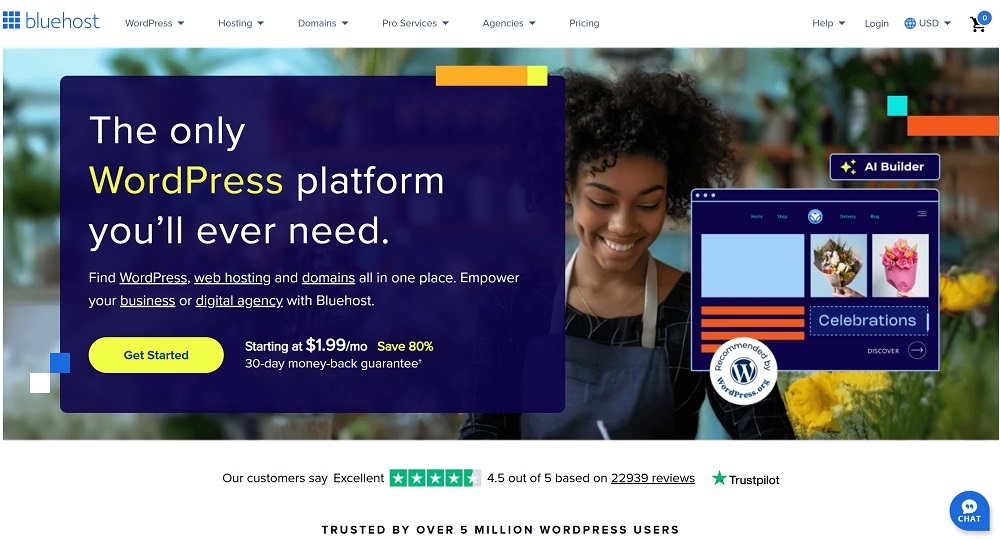Bluehost and DreamHost are two giants in the web hosting industry. At a glance, there isn’t a huge difference between them, but certain details set each apart.
Bluehost stands out for its beginner-friendly features, ease of use, and fast customer support. DreamHost, on the other hand, offers an excellent balance of server performance, strong security and privacy protections, and affordable scalability.
Below is a structured comparison to help you choose the best fit for your website.
Overview: Bluehost and DreamHost Compared
We tested dozens of popular web hosting providers based on speed, uptime, support, and usability. Here are the highlights:
- Hostinger is our top pick overall for its storage, free domain, unlimited bandwidth, and ability to host up to 100 websites, even on the cheapest plan.
- Bluehost offers the easiest WordPress setup with guided onboarding, free themes, and a powerful drag-and-drop builder.
- HostGator is ideal for ecommerce sites and those expecting rapid growth.
- DreamHost stands out with affordable short-term pricing, a 97-day money-back guarantee, and strong security features.
While Hostinger is our favorite, both Bluehost and DreamHost deliver robust functionality for different needs.
Bluehost at a Glance
If you want the easiest way to build a WordPress website, Bluehost is hard to beat.

Strengths:
- Beginner-friendly onboarding and interface.
- Flexible WordPress builder with extensive customization, ideal for users with no coding experience.
- cPanel + Maestro: Familiar control panel plus Maestro for managing multiple sites efficiently.
- Built-in features like Cloudflare CDN, free WordPress themes, and at least one free email address per plan.
- Fast support: Average wait time is just a few minutes, even by phone.
- Affordable WooCommerce hosting with generous storage and free ecommerce plugins.
- AI site builder: Build an entire website in minutes by answering a few questions.
- WonderSuite: A toolkit to simplify design and ecommerce customizations, included with all plans.
Weaknesses:
- Aggressive upsells during checkout, some pre-selected by default.
- Paid domain privacy, unlike DreamHost which offers it for free.
- Opaque server locations, with no disclosure on their website.
- Overwhelming number of plans, causing confusion for beginners.
- Difficult cancellation process, requiring a phone call.
- Expensive cloud hosting, starting at $29.99/month.
- No managed WordPress hosting, which DreamHost offers for extra support and automation.
DreamHost at a Glance
If you value security, simplicity, and affordable VPS or cloud hosting, DreamHost is an excellent choice.

Strengths:
- Cheaper short-term plans, with clear monthly pricing and only two shared hosting options.
- Minimalist, no-frills interface, ideal for beginners and developers alike.
- Free WHOIS privacy, included with all domains.
- Strong security features, including two-factor authentication, daily backups, SSL certificates, and automated updates.
- Generous money-back guarantee, with 97 days for shared hosting.
- Easy cancellation directly within your dashboard.
- Affordable VPS plans, starting at one-third of Bluehost’s price.
- Cloud hosting options, flexible and developer-friendly.
- Standalone email hosting with 25GB storage and advanced spam filtering.
- Fully managed WordPress hosting, with automated backups, caching, and specialized support.
Weaknesses:
- Less flexible WordPress builder, though it has improved in recent years.
- Slower support response times, averaging 30–60 minutes for live chat.
- No free email with the cheapest shared plan, unlike Bluehost.
- Limited ecommerce entry-level options, with WooCommerce plans starting at $16.95/month but less storage and features than Bluehost.
- Expensive dedicated servers, starting at $149/month, nearly twice the price of Bluehost.
Key Similarities
Both Bluehost and DreamHost offer:
- Easy WordPress installation, often pre-installed depending on the plan.
- Free domains (first year) with 12-month or longer contracts.
- Higher domain renewal rates, $3–$5/year more than domain registrars.
- Stable performance, with neither excelling nor underperforming in our speed and uptime tests.
- High renewal prices after the initial contract period.
- WordPress.org recommendations, alongside Hostinger.
- Scalable hosting options, from shared hosting to VPS, cloud, and dedicated servers.
- 24/7 support, with Bluehost slightly faster on average.
- Money-back guarantees, with DreamHost offering a market-leading 97 days for shared hosting (Bluehost offers 30 days).
Final Verdict
Both Bluehost and DreamHost are solid choices for launching and growing your website. Your decision comes down to specific needs:
✅ Choose Bluehost if you want:
- The easiest WordPress onboarding
- Powerful design flexibility with AI builder and WonderSuite
- Fast, responsive customer support
- Affordable WooCommerce hosting with rich ecommerce features
✅ Choose DreamHost if you want:
- Month-to-month pricing without long-term contracts
- Strong security and privacy protections
- Affordable VPS and cloud hosting options
- A minimalistic, straightforward interface
In most cases, either will help you build a fast, secure, and reliable website with ease.
FAQs
Is Bluehost faster than DreamHost?
DreamHost has faster average response times (813ms vs. 1107ms) and better uptime based on our tests.
Which is cheaper?
DreamHost’s shared hosting starts at $2.59/month (3-year plan) compared to Bluehost’s $4.95/month.
Which is better for WordPress?
Both are officially recommended by WordPress.org. Bluehost is ideal for new WordPress users, while DreamHost offers managed plans for extra peace of mind.
Which is better for ecommerce?
Bluehost provides richer ecommerce features and better value for WooCommerce hosting.
Which is more beginner-friendly?
Bluehost is generally easier for first-time website creators with its step-by-step setup and integrated tools.
